Philips AZ9202, AZ9203, AZ9003 User Manual
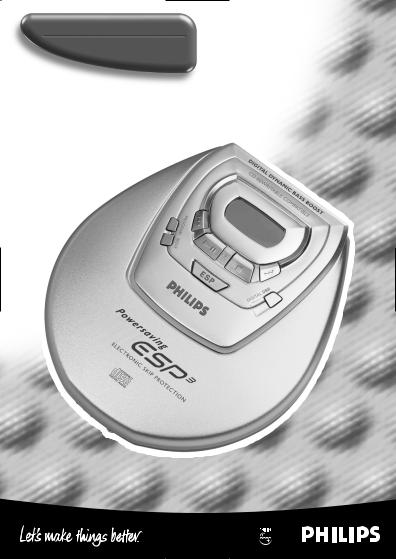
AZ9001
Shockproof CD Player
AZ9002
AZ9003
AZ9011
AZ9201
AZ9202
AZ9203
AZ9211
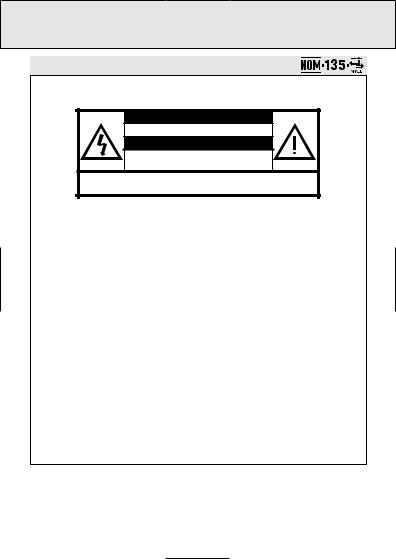
México
Es necesario que lea cuidadosamente su instructivo de manejo.
PRECAUCIÓN - ADVERTENCIA
No abrir, riesgo de choque eléctrico
ATENCIÓN
Verifique que el voltaje de alimentación sea el requerido para su aparato
Para evitar el riesgo de choque eléctrico, no quite la tapa. En caso de requerir servicio, dirijase al personal calificado.
Descripción: |
Tocadiscos de CD portatil |
Modelo: |
AZ 9001/01, /11, /16, AZ 9002/01, /11, /16, |
|
AZ 9003/01, /11, /16, AZ 9011/01, /11, /16, |
|
AZ 9201/01, /11, /16, AZ 9202/01, /11, /16, |
|
AZ 9203/01, /11, /16, AZ 9211/01, /11, /16 |
Alimentación: |
110–127/220–240 V~ 50–60 Hz |
Consumo: |
4 W (AY 3170) |
Importador: |
Philips Mexicana, S.A. de C.V. |
Domicilio: |
Norte 45, # 669, Col. Industrial Vallejo |
Localidad y Telefono: C.P. 02300 México D.F., Tel. 728 42 00 |
|
Exportador: |
Philips Hong Kong, Ltd. |
País de Origen: |
China |
Nº de Serie: |
______________________________ |
LEA CUIDADOSAMENTE ESTE INSTRUCTIVO
ANTES DE USAR SU APARATO.
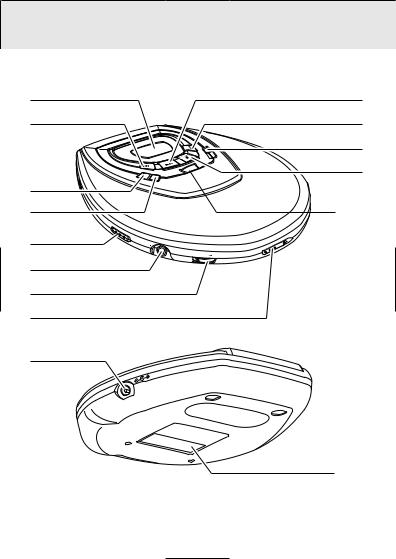
5
6
7
8
9
0
!
@
#
PROGRAM MODE
O
F
F
•
R
E
S U M E • H O L D
 LINE OUT/
LINE OUT/
|
|
4 |
|
|
3 |
|
|
2 |
|
BB |
|
|
D |
|
|
ITAL |
|
|
DIG |
1 |
ESP |
|
|
|
|
% |
|
|
OPEN |
|
VOL. |
|
|
0 |
|
V |
DC |
4,5 |
|
$
3

4
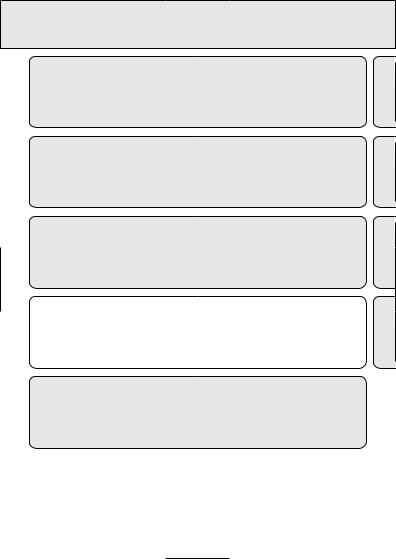
English |
|
Controls ................................................. |
6 |
Quick start ............................................. |
7 |
Power supply................................... |
8–10 |
Headphones......................................... |
10 |
Français |
|
Commandes ......................................... |
22 |
Mise en service rapide........................ |
23 |
Alimentation électrique ................ |
24–26 |
Ecouteurs ............................................. |
26 |
Español |
|
Controles ............................................. |
38 |
Encendido rápido................................. |
39 |
Alimentación eléctrica .................. |
40–42 |
Auriculares .......................................... |
42 |
General information ............................ |
11 |
CD play .......................................... |
12–13 |
Features......................................... |
14–18 |
In-car connection................................. |
19 |
Troubleshooting............................. |
20–21 |
Informations générales ....................... |
27 |
Lecture CD..................................... |
28–29 |
Caractéristiques ............................ |
30–34 |
Raccordement en voiture .................... |
35 |
Pannes et remèdes ....................... |
36–37 |
Información general ............................ |
43 |
Reproducción de un CD................. |
44–45 |
Características .............................. |
46–50 |
Conexión al automóvil......................... |
51 |
Localización de averías ................. |
52–53 |
∑ Español Français
Guarantees |
Philips product warranty for |
|
|
Australia ...................................... |
72–73 |
Polizia de garantía |
Guarantee and service for |
|
Mexico......................................... |
70–71 New Zealand .................................... |
74 |
5

English
CONTROLS, refer to the illustration on page 3
1 9 |
.....................stops CD play, clears a program or switches the player off |
2 DIGITAL DBB ...DIGITAL DYNAMIC BASS BOOST switches the bass enhancement on and off
3 |
§.................... |
skips and searches CD tracks forwards |
4 |
2;................... |
switches the player on, starts or pauses CD play |
5 |
........................ |
display |
6 |
∞.................... |
skips and searches CD tracks backwards |
7 PROGRAM....... |
programs tracks and reviews the program |
|
8 MODE.............. |
selects the different playing possibilities: SHUFFLE, |
|
|
|
SHUFFLE REPEAT ALL, REPEAT, REPEAT ALL and SCAN |
9 RESUME.......... |
stores the last position of a CD track played |
|
|
HOLD .............. |
locks all buttons |
|
OFF .................. |
switches RESUME and HOLD off |
0 LINE OUT/p.... |
3.5 mm headphone socket, socket to connect the player to another |
|
|
|
analogue audio input of an additional appliance, remote control |
|
|
socket (not on all versions) |
!VOL E.........adjusts the volume
@OPEN 2...........opens the CD lid
# 4.5V DC |
...........socket for external power supply |
$ ........................ |
typeplate |
% ESP .................. |
ELECTRONIC SKIP PROTECTION ensures continuous CD playback |
|
regardless of vibrations and shocks |
This set complies with the radio interference requirements of the European Community.
6
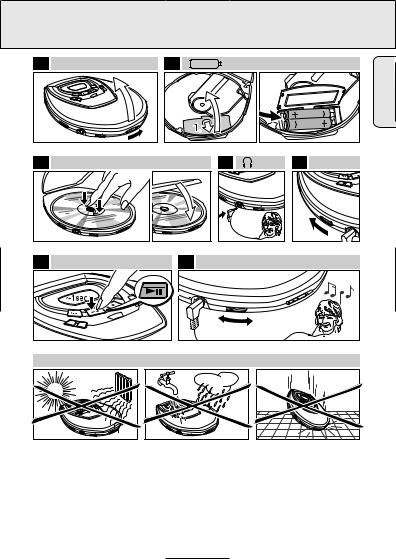
QUICK START
1 OPEN |
2 |
FF•RESU |
|
|
2. |
O |
|
|
|
ME |
|
|
|
|
•H |
|
|
|
OLD |
|
|
|
LINE OUT/ |
|
1. |
|
|
VOL. |
|
|
|
0 |
|
3 |
CD |
|
|
OFF |
|
|
|
•R |
|
|
|
ESU |
|
|
|
ME•H |
|
|
|
|
OLD |
|
|
|
LINE OUT/ |
|
|
6 |
PLAY |
|
|
|
|
|
NE |
|
PROGRAM |
MODE |
ESP |
|
|
||
!!!
2. |
AA |
English |
|
LR6 |
|
|
UM3 |
|
1. |
|
|
4 |
5 HOLD OFF |
 LINE OU
LINE OU
T/
VO L.
0
7 VOLUME 
OUT/

VOL.
0
O
F
F
•
R
E SU M E • H O LD
LINE OUT/
N
OPE
L
I
O
U
T/
O F F • R E
S U M E • H OL
7
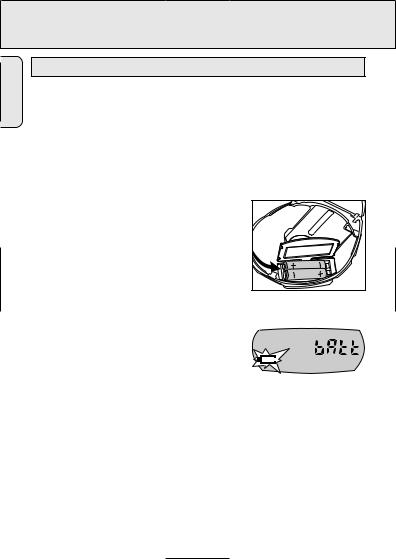
POWER SUPPLY
English
Batteries (supplied or optionally available)
With this player you can use either:
•normal batteries type LR6, UM3 or AA (preferably Philips), or
•alkaline batteries type LR6, UM3 or AA (preferably Philips).
Notes: – Old and new or different types of batteries should not be used in combination.
–Remove batteries if they are empty or if the player is not going to be used for a long time.
Inserting batteries
1Push OPEN 2 to open the CD lid.
2Open the battery compartment and insert either 2 normal or alkaline batteries.
Battery indication
The battery symbol on the display is divided into 3 sections which indicate the approximate power capacity of the batteries.
•If A is flashing and bAtt is displayed, the batteries are empty.
Average playing time of batteries under normal conditions |
|
|
|||
Battery type |
ESP on |
ESP off |
|||
Normal |
7 |
hours |
6 |
hours |
|
|
|
|
|
|
|
Alkaline |
|
20 |
hours |
18 |
hours |
|
|
|
|
|
|
ECO-PLUS NiMH batteries (not on all versions) |
10 |
hours |
9 |
hours |
|
Batteries contain chemical substances, so they should be disposed of properly.
8
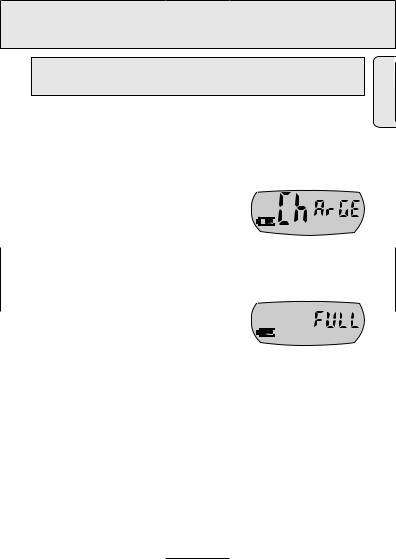
POWER SUPPLY
ECO-PLUS NiMH battery information (for versions supplied with rechargeable ECO-PLUS NiMH batteries AY 3362 only)
Recharging works only on players with supplied rechargeable
ECO-PLUS NiMH batteries AY 3362.
Recharging the ECO-PLUS NiMH batteries on board
1Make sure you insert the rechargeable ECO-PLUS NiMH batteries AY 3362.
2 Connect the mains adapter to the 4.5V DC socket of the player and to the wall socket.
y A filled with 0–3 sections (depending on the level of charge) is shown and ChArGE is displayed.
•Recharging stops when you start playback or when approximately 7 hours have passed by.
3 When the batteries are fully recharged,  is shown and FULL is displayed.
is shown and FULL is displayed.
Notes: – It is normal for the batteries to become warm during recharging.
–If the batteries become too warm, recharging will be interrupted for approximately 30 minutes and Hot is displayed.
–To ensure proper recharging on board, take care that contacts are clean, and you are using only the ECO-PLUS NiMH batteries AY 3362.
Rechargeable ECO-PLUS NiMH battery handling
•Recharging already charged or half-charged batteries will shorten their lifetime. Therefore, after using the rechargeable ECO-PLUS NiMH batteries a few times, discharge them completely before recharging.
•To avoid a short circuit, the batteries should not touch any metal objects.
•When the batteries quickly become empty after recharging, the contacts are dirty or the end of their lifetime has been reached.
English
9

POWER SUPPLY/HEADPHONES
English
Mains adapter (supplied or optionally available)
Use only the AY 3170 adapter (4.5 V/300 mA direct current, positive pole to the centre pin). Any other product may damage the player.
1Make sure that the local voltage corresponds to the mains adapter´s voltage.
2Connect the mains adapter to the 4.5V DC socket of the player and to the wall socket.
Note: Always disconnect the adapter when you are not using it.
4,5V
DC
Headphones AY 3677
•Connect the supplied headphones to the LINE OUT/p socket.
Note: LINE OUT/p can also be used for connecting your HiFi system (signal lead) or your car radio (cassette adapter or signal lead). In both cases, the volume of the player must be set to position 8.
H O L D
 LINE
LINE
OUT/
VO 0
L.
Use your head when using headphones
Hearing safety: Do not play your headphones at a high volume. Hearing experts advise that continuous use at high volume can permanently damage your hearing.
Traffic safety: Do not use headphones while driving a vehicle. It may create a hazard and it is illegal in many countries. Even if your headphones are an open-air type designed to let you hear outside sounds, do not turn up the volume so high that you cannot hear what is going on around you.
10

GENERAL INFORMATION
CD player and CD handling
• |
Do not touch the lens A of the CD player. |
|
• |
Do not expose the set, batteries or CDs to humidity, |
A |
|
rain, sand or excessive heat (caused by heating |
|
|
equipment or direct sunlight). |
•You can clean the CD player with a soft, slightly  dampened, lint-free cloth. Do not use any cleaning
dampened, lint-free cloth. Do not use any cleaning
agents as they may have a corrosive effect.
•To clean the CD, wipe it in a straight line from the centre towards the edge using a soft, lint-free cloth. A cleaning agent may damage the disc! Never write on a CD or attach a sticker to it.
•The lens may cloud over when the set is moved suddenly from cold to warm surroundings. Playing a CD is not possible then. Leave the CD player in a warm environment until the moisture has evaporated.
•Active mobile phones in the vicinity of the CD player may cause malfunctions.
•Avoid dropping the set as this may cause damage.
Environmental information
•All redundant packing material has been omitted. We have done our utmost to make the packaging easily separable into two mono materials: cardboard (box) and polyethylene (bags, protective foam sheet).
•Your set consists of materials which can be recycled if disassembled by a specialized company. Please observe the local regulations regarding the disposal of packing materials, exhausted batteries and old equipment.
English
11

CD PLAY
English
Playing a CD
This CD player can play all kinds of Audio Discs such as CD-Recordables and CD-Rewritables. Do not try to play a CD-ROM, CDi, VCD, DVD or computer CD.
1Push the OPEN 2 slider. y The lid opens.
2Insert an audio CD, printed side up, by pressing gently on the CD centre so that it fits onto the hub.
Close the lid by pressing it down.
3Press 2; for approximately 1 second to switch the player on and start CD playback.
yThe current track number and the elapsed playing time are displayed.
•You can pause playback by pressing 2;.
yThe time where playback was paused is flashing.
•Continue playback by pressing 2; again.
4Press 9 to stop playback.
y The total number of tracks and the total playing time of the CD are displayed.
5Press 9 again to switch the player off.
•To remove the CD, hold it by its edge and press the hub gently while lifting the CD.
Note: If there is no activity, the set will automatically switch off after a while to save energy.
OPEN |
VOL. |
0 |
DBB |
AL |
IGIT |
D |
ESP |
AM |
MODE |
12

|
|
CD PLAY |
|
||
|
|
|
|
||
|
Playback information |
|
English |
||
• |
If a recordable CD (CD-R) or a rewritable CD (CD-RW) is not recorded |
||||
|
|||||
|
|
properly, nF dISC is displayed. In that case use FINALIZE on your |
|
||
|
|
CD recorder to complete the recording. |
|
||
• |
If you want to play a rewritable CD (CD-RW), it takes 3–15 seconds for |
|
|||
|
|
sound reproduction to start once you have pressed 2;. |
|
||
• |
Playback will stop if you open the CD lid. |
|
|||
• |
While the CD is read, 1 -:- is flashing. |
|
|||
Volume and bass
Volume adjustment
• Adjust the volume by using VOL E.
Bass adjustment
You can choose between the bass enhancement levels dbb1 and dbb2.
1Press DIGITAL DBB as often as necessary to select the desired bass intensity.
y dbb1 or dbb2 is displayed for 2 seconds and
 is shown.
is shown.
2To switch dbb1 or dbb2 off, press DIGITAL DBB
repeatedly.
y  goes off.
goes off.
VOL. |
0 |
DBB |
AL |
DIGIT |
ESP |
13
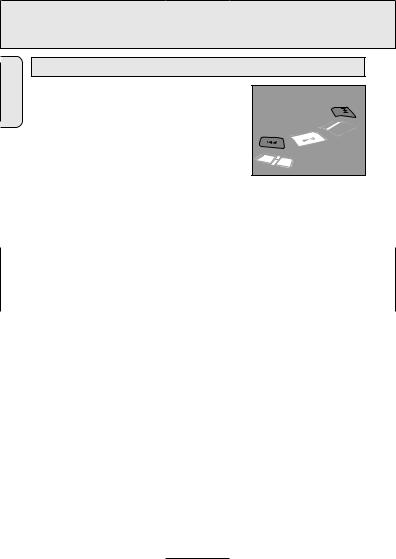
FEATURES
English
Selecting a track and searching |
|
|
|
Selecting a track during playback |
|
|
|
• |
Briefly press ∞ or § once or several times to skip to |
|
|
|
the current, previous or next track. |
|
B |
|
y Playback continues with the selected track and |
|
|
|
its number is displayed. |
|
ESP |
|
|
PROGRAM |
|
|
|
MODE |
|
|
|
|
|
Selecting a track when playback is stopped |
|
|
|
1 |
Briefly press ∞ or § once or several times. |
|
|
|
y The selected track number is displayed. |
|
|
2 |
Press 2; to start CD play. |
|
|
|
y Playback starts with the selected track. |
|
|
Searching for a passage during playback
1Keep ∞ or § pressed to find a particular passage in a backward or forward direction.
ySearching is started and playback continues at low volume. After 2 seconds the search speeds up.
2Release the button when you reach the desired passage. y Normal playback continues from this very position.
Notes: – During SCAN searching is not possible.
–During SHUFFLE, SHUFFLE REPEAT ALL, REPEAT or while playing a program, searching is only possible within the particular track.
14
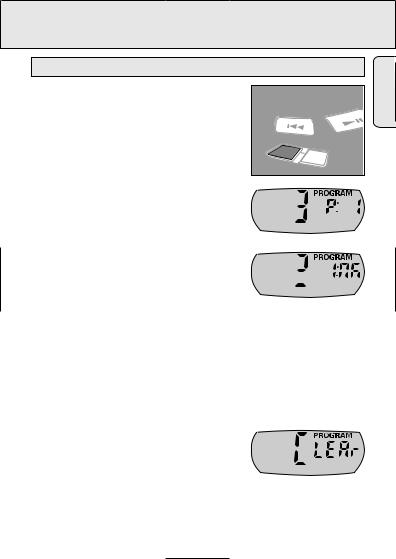
FEATURES
Programming track numbers
You can select up to 99 tracks and store them in memory in a desired sequence. Any track can be stored more than once.
1While playback is stopped, select a track with ∞ or §.
2Press PROGRAM to store the track.
y PROGRAM lights up; the track number programmed and P with the total number of stored tracks are displayed.
3Select and store all desired tracks in this way.
4Press 2; to start playback of your selected tracks.
PROGRAM |
MODE |
|
yPROGRAM is shown and playback starts. 


•You can review the program by pressing PROGRAM for more than 2 seconds.
yThe display shows all stored tracks in sequence.
Notes: – If you press PROGRAM and there is no track selected, SELECt is displayed.
– If you try to store more than 99 tracks, FULL is displayed.
Clearing the program
1 If necessary, press 9 to stop playback.
2 Press 9 to clear the program.
y CLEAr is displayed once, PROGRAM goes off and the program is cleared.
Notes: The program will also be cleared if you
–interrupt the power supply or
–open the CD lid,
–or if the set switches off automatically.
English
15
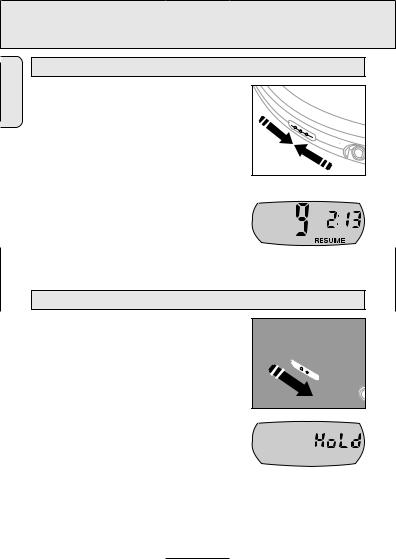
FEATURES
English
Storing the last position played – RESUME
You can store the last position played. When restarting, playback continues from where you have stopped.
1Switch the slider to RESUME during playback to activate RESUME.
y RESUME is shown.
2Press 9 whenever you want to stop playback.
3Press 2; whenever you want to resume playback.
y RESUME is shown and playback continues from where you have stopped.
•To deactivate RESUME, switch the slider to OFF. y RESUME goes off.
O
F
F
•
R
E
S
U
M
E
•
H
O
L
D
 LINE
LINE
OUT/
Locking all buttons – HOLD
You can lock the buttons of the set. When a key is pressed, no action will be executed then.
1Switch the slider to HOLD to activate HOLD.
y All buttons are locked. HoLd is displayed by pressing any key. If the set is switched off, HoLd is displayed only by pressing 2;.
2To deactivate HOLD, switch the slider to OFF.
Note: When you deactivate HOLD by switching the slider to RESUME and restart, playback continues from where you have stopped.
O
F
F
•
R
E
SU
M
E
•
H
O
L
D
 LINE
LINE
OUT/
16
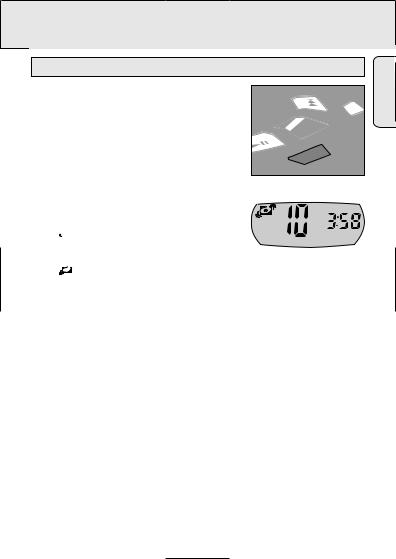
|
FEATURES |
|
ESP |
English |
|
With a conventional portable CD player you might |
||
|
||
have experienced that the music stopped e.g. when you |
|
|
were jogging. The ELECTRONIC SKIP PROTECTION |
DBB |
|
prevents loss of sound caused by light vibrations and |
AL |
|
DIGIT |
||
shocks. Continuous playback is ensured. |
|
|
However, ESP does not prevent playback interruptions |
ESP |
|
during serious running. It also does not protect the set |
||
|
||
against any damage caused by dropping! |
|
•Press ESP during playback to activate the skip protection.
y 

 is shown and the protection is activated.
is shown and the protection is activated.
•To deactivate the skip protection, press ESP again. y 
 goes off and the protection is deactivated.
goes off and the protection is deactivated.
17

FEATURES
English
Selecting different playing possibilities – MODE
It is possible to play tracks in random order, to repeat a track or the CD and to play the first few seconds of each track.
1Press MODE during playback as often as necessary until the display shows either:
y SHUFFLE: All tracks of the CD are played in
random order until all of them have been played once.
y SHUFFLE REPEAT ALL: All tracks of the CD are played repeatedly in random order.
yREPEAT: The current track is played repeatedly.
yREPEAT ALL: The entire CD is played repeatedly.
ySCAN: The first 10 seconds of each of the
remaining tracks are played in sequence.
PROGRAM |
MODE |
|
2 Playback starts in the chosen mode after 2 seconds.
•To return to normal playback, press MODE repeatedly until the display indicator goes off.
18
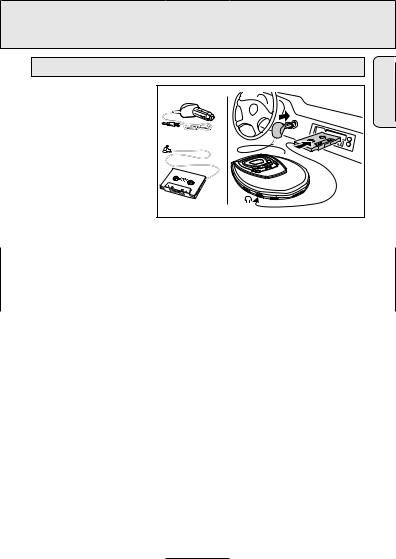
IN-CAR CONNECTION
In-car use (connections supplied or optionally available)
Only use the AY 3545 car voltage converter (4.5 V, DC, positive pole to the centre pin) and the AY 3501 car cassette adapter. Any other product may damage the set.
1 Put the CD player on a
horizontal, vibration-free and stable surface. Make sure it is in a safe place, where the
player is neither a danger
nor obstacle to the driver and passengers.
4,5 V DC
O F F • R E
S U M E • H OLD
 LINE OU
LINE OU
T/
2Connect the DC plug of the voltage converter to the 4.5V DC socket of the CD player (only for a 12 V car battery, negative grounding).
3Insert the voltage converter into the cigarette lighter socket. If necessary, clean the cigarette lighter socket to obtain a good electrical contact.
4Turn down the volume and connect the cassette adapter plug to the LINE OUT/p socket of the CD player.
5Carefully insert the cassette adapter into the car radio’s cassette compartment.
6Make sure the cord does not hinder your driving.
7Start the CD player, set VOL E to position 8 and adjust the sound with the car radio controls.
•Always remove the voltage converter from the cigarette lighter socket when the CD player is not in use.
Notes: – Avoid excessive heat from the car heating or from direct sunlight (e.g. in a parked car in the summer).
–If your car radio has a LINE IN socket, it is better to use it for the car radio connection instead of the cassette adapter. Connect the signal lead to this LINE IN socket and to the LINE OUT/p socket of the CD player.
English
19
